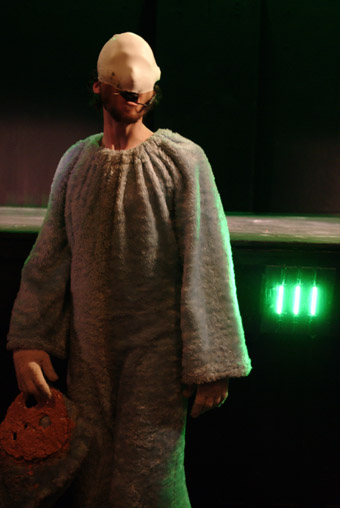Wronged animals, bodily remains
David Williams on Adam Broinowski in performance

dam Broinowski, Vivisection Vision: animal reflections
photo Heidrun Löhr
dam Broinowski, Vivisection Vision: animal reflections
In this stark and disquieting solo, Adam Broinowski presents the body as the broken remainder of discourses of war and terror that seek to erase and remove it from vision. With war reduced to triumphalist rhetoric and video game images, what remains of the body? At a ‘safe’ distance from the suffering of others occurring in our name, how are images of war internalised in the bodies of democratic ‘free’ citizens? As the late Susan Sontag observed, “there is no ‘we’ when regarding the pain of others” (Sontag, Regarding the Pain of Others, 2003). In the breakdown of the democratic ‘we’ produced by the relentless progression of images of violence and suffering, Broinowski intervenes by performing his intimate nightmare visions of the body politic.
First vision. From behind tensed crossed wires that surgically quarter the stage (a dissection? a rifle sight? a cage?) and covered in grey fur (a scruffy and broken koala-like beast with a melted face of clay) Broinowski glides onstage glowing fluorescent green. This strange, clearly damaged human/imal twitches awkwardly under the night vision green, the kind of light in which so often we watch other humans violently erased in ‘smart bomb’ footage. The sheer misery of Broinowski’s broken animal brings to mind Steve Baker’s thoughts on “botched taxidermy”: “a fractured, awkward, ‘wrong’ or wronged thing, which is hard not to read as a means of addressing what it is to be human now” (Steve Baker, The Postmodern Animal, 2000).
I imagine tracer fire across this wrong(ed) animal body as he disturbingly thrusts fingers into the eye holes of the mask as if to tear off his ruined face, or as if, like Oedipus, he has been forced to see far, far too much. Beneath the mask is a flesh-toned skullcup that also erases Broinowki’s face, smoothing it out, leaving him eyeless and hairless. In his mouth is embedded a small wireless camera, through which he looks out at us in the dark. He looks without seeing, yet records everything. De-humanised, he becomes a seeing machine, with the technological apparatus that produces an image literally hard to swallow.
Second vision. The stage is drenched in red fluorescent light, a photographic darkroom for this dark time. Shorn of his fur, Broinowski re-enters dragging a bulging balloon that wobbles amusingly yet pathetically. He’s unable to tame the beast that is the balloon, its sheer stubborn excess of materiality escaping the flow of the rhetoric of violence.
Third vision. The subtitle “animal reflections” is here literalised, with a large mirror that slides painfully down the performer’s back. Later, it becomes the reflective ground upon which he kneels, giving this warring body a long hard look at itself. This body is at war with itself, with the animal within, and with the framing discourses of terror surrounding, demeaning and erasing the human. For the first and last time, he speaks:
There is no animal as cruel as human
There is no animal as bright
A thousand suns, each one brighter than the last
A desert full of empty shells
All is gone, all is gone, all …
The being that Adam Broinowski presents looks without seeing, and kills without either touching or caring, possessing a cruelty far beyond any other predator.
In the end all we have left are images of ourselves recorded earlier, blindly, from the mouth, a reflection of the strange and frightening animal we have become: the audience.
Vivisection Vision: animal reflections, performer-director Adam Broinowski, lighting Stephen Klinder; Performance Space, June 1-3
RealTime issue #74 Aug-Sept 2006 pg. 47






